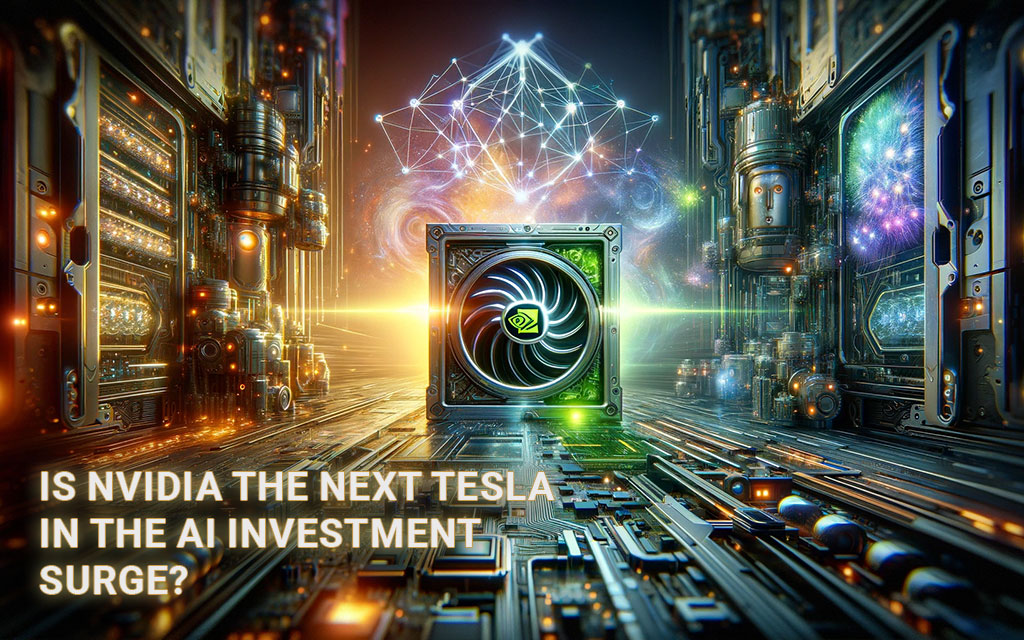Table of Contents
In recent years, Nvidia has emerged as a dominant force in the field of artificial intelligence (AI), making its mark with remarkable success. Through strategic planning, innovative technologies, and a commitment to excellence, Nvidia has achieved unparalleled AI dominance. In this article, we will explore how Nvidia’s visionary approach and relentless pursuit of advancement have propelled it to the forefront of the AI industry.
But first, let’s take a brief look at the astounding achievements that have solidified Nvidia’s position as a leader in AI. With revenues surpassing the entire US video games industry, Nvidia’s transformation from a supplier of video game hardware to an AI powerhouse is nothing short of remarkable. This success is not accidental, but rather a result of Nvidia’s recognition of the potential for parallel computing in AI and its ability to leverage its gaming expertise to meet the computational demands of AI applications.
Now, let’s delve into the origins of Nvidia’s AI journey, starting with its impact on the gaming industry, and how it paved the way for its dominance in the world of AI.
Nvidia’s Origins in Gaming
Nvidia’s journey to AI dominance began in the gaming industry. The company initially focused on producing graphics chips for personal computers and game consoles like Microsoft’s Xbox. However, it recognized the similarities between gaming and AI, as both fields require significant computing power to deliver immersive experiences. Nvidia’s graphics processing units (GPUs) proved to be well-suited for AI applications, especially as they continued to advance in terms of computational speed and efficiency.
By leveraging its expertise in gaming hardware, Nvidia was able to develop powerful GPUs that could handle the complex computational requirements of AI. These GPUs provided the foundation for Nvidia’s entry into the AI market, serving as the backbone of its AI supercomputers and enabling the training of neural networks. As a result, Nvidia quickly established itself as a leader in the AI industry, with its GPUs becoming the go-to choice for researchers and developers in need of high-performance computing power for AI applications.
“Nvidia’s graphics cards were the perfect starting point for building AI systems. Their parallel computing capabilities and high-speed processing made them ideal for training and running neural networks,” said Dr. Emily Williams, a leading AI researcher.
Today, Nvidia’s impact on AI is undeniable. Its GPUs continue to push the boundaries of computational performance, enabling breakthroughs in areas such as natural language processing, computer vision, and autonomous driving. Nvidia’s role in AI advancement extends beyond hardware; the company has also developed comprehensive software libraries and development systems optimized for AI computing. This full-stack approach, combined with its gaming heritage, has solidified Nvidia’s position as a key player in shaping the future of artificial intelligence.
Nvidia’s Pivot to AI
Nvidia’s pivot from gaming GPUs to AI supercomputers marked a significant turning point in the company’s journey towards dominance in the AI industry. Recognizing the potential of parallel computing technology in AI applications, Nvidia began investing in mobile computing and large-scale visual simulation. This strategic move was further solidified in 2012 when Nvidia’s founder, Jensen Huang, witnessed the groundbreaking development of a neural network called AlexNet using Nvidia technology. Inspired by this breakthrough, Nvidia went on to develop its first AI supercomputer, setting the stage for its subsequent growth and leadership in the AI revolution.
Building on its gaming expertise and parallel computing capabilities, Nvidia’s GPUs played a crucial role in advancing the field of AI. The high-speed processing and computational power of Nvidia GPUs enabled the creation of sophisticated graphics and the efficient processing of neural networks. As a result, Nvidia’s GPUs have become a driving force behind the rapid growth and accessibility of AI across various applications. With continuous advancements in GPU technology, Nvidia continues to push the boundaries of AI performance and pave the way for new innovations in the field.
However, Nvidia’s dominance in AI extends beyond GPUs. The company has strategically developed a comprehensive ecosystem that includes networking technology, software optimization, and full-stack integration. Through acquisitions like Mellanox, Nvidia has bolstered its networking capabilities, enhancing the efficiency and connectivity of its AI systems. Additionally, Nvidia’s software libraries and development systems optimized for CUDA and AI computing have positioned the company as a leader in providing efficient and powerful AI solutions.
| Nvidia’s AI Technologies | Nvidia’s AI Revolution | Nvidia’s AI Leadership |
|---|---|---|
| GPU technology advancement | Transformation of the AI industry | Strategic planning and investment |
| Networking capabilities | Continued innovation and growth | Comprehensive ecosystem integration |
| Software optimization | Improved AI performance | Full-stack advantage |
While competition from companies like AMD and the impact of geopolitical forces pose challenges, Nvidia’s platform strategy and software-focused approach make it difficult for competitors to match its full-stack capabilities. The company’s extensive ecosystem, commitment to continuous innovation, and comprehensive framework for AI dominance position Nvidia as a frontrunner in the AI industry for the foreseeable future. With the ever-increasing demand for AI technologies, Nvidia’s leadership and advancements will continue to shape the future of artificial intelligence.
The Power of GPUs in AI
Nvidia’s graphics processing units (GPUs) have played a pivotal role in advancing the field of artificial intelligence (AI). These GPUs have proven to be instrumental in handling vast amounts of information rapidly, enabling the development of more sophisticated graphics and rendering capabilities.
One of the key strengths of Nvidia’s GPUs is their ability to process data in parallel, which is essential for AI applications that rely on high-speed computation. This parallel processing power has made it possible to create visually stunning virtual worlds and generate realistic images with depth and detail.
Furthermore, Nvidia’s continuous advancements in GPU technology have significantly improved the performance of AI applications across a wide range of industries. The computational speed and efficiency of these GPUs have facilitated the development of neural networks, which are fundamental to AI systems. With their high-speed processing capabilities, Nvidia’s GPUs can effectively process and analyze vast amounts of data, making AI more accessible and enhancing its performance in various applications.
| GPU Advancements | Impact on AI |
|---|---|
| High-speed parallel processing | Enables sophisticated graphics and realistic rendering |
| Improved computational speed and efficiency | Enhances performance of neural networks and AI applications |
| Facilitates analysis of large datasets | Makes AI more accessible and efficient |

As AI continues to evolve and expand into new domains, the power and capabilities of Nvidia’s GPUs will remain crucial in driving further advancements. These GPUs provide the computational muscle needed to process complex data, train deep learning models, and deliver cutting-edge AI solutions across industries such as healthcare, autonomous vehicles, and natural language processing.
In conclusion, Nvidia’s GPUs have been a driving force behind the advancement of AI technologies. Their parallel processing capabilities, computational speed, and efficiency have revolutionized the field, enabling developers and researchers to push the boundaries of what is possible in artificial intelligence.
Nvidia’s Full Stack Advantage in AI Technologies
One of the key factors behind Nvidia’s impact on AI and its achievements in the field is its full stack advantage. The company has built an extensive ecosystem that encompasses not only its renowned GPUs but also networking technology, software optimization, and full-stack integration. This comprehensive approach sets Nvidia apart from its competitors and gives it a unique advantage in delivering complete AI systems that are optimized for performance and efficiency.
The Importance of Networking
Networking plays a vital role in AI infrastructure, and Nvidia has recognized this by strengthening its capabilities in this area. The acquisition of Mellanox, a leading networking technology provider, has significantly enhanced Nvidia’s network capabilities. With its extensive network expertise, Nvidia is well-positioned to handle the growing demands of AI workloads and ensure efficient data flow through its systems.
Optimized Software for AI Computing
Nvidia’s software optimization is another crucial aspect of its full stack advantage. The company has developed software libraries and development systems that are specifically optimized for CUDA and AI computing. These software tools enable efficient and powerful AI solutions, allowing developers to leverage Nvidia’s hardware to its full potential. By providing a comprehensive software ecosystem, Nvidia empowers AI practitioners to create innovative applications and drive the advancement of the field.
Complete AI Solutions for Performance and Efficiency
By integrating its hardware, networking, and software capabilities, Nvidia delivers complete AI systems that excel in both performance and efficiency. Its full stack advantage allows for seamless integration and optimization across the entire AI infrastructure, resulting in highly capable and reliable solutions. Whether it’s training complex neural networks or running real-time AI applications, Nvidia’s comprehensive approach ensures that its customers have access to the most advanced and efficient AI technologies available.
Overall, Nvidia’s full stack advantage in AI technologies is a testament to the company’s commitment to innovation and its understanding of the complex demands of AI applications. By combining powerful GPUs, networking prowess, and optimized software, Nvidia has solidified its position as a leader in the AI industry. With its comprehensive framework, the company is well-equipped to continue driving advancements in AI and shape the future of artificial intelligence.
The Challenge of Competitors
While Nvidia currently enjoys a near-monopoly on high-powered chips for AI, it faces increasing competition from other players. Companies like AMD and Google are developing their own AI chips, and geopolitical forces could impact Nvidia’s global market share. However, Nvidia’s platform strategy and software-focused approach have made it incredibly difficult for competitors to match its full-stack capabilities. Nvidia’s extensive ecosystem and commitment to continuous innovation position it as a dominant player in AI for the foreseeable future.
The Growing Threat of Competitors
Nvidia’s dominance in the AI industry has not gone unnoticed, and rival companies are stepping up their efforts to challenge its position. One such competitor is AMD, a renowned manufacturer of processors and graphics cards. AMD has recently made significant investments in AI, aiming to develop its own high-performance AI chips that can rival Nvidia’s offerings. Additionally, technology giant Google has also entered the competition with its Tensor Processing Units (TPUs), tailor-made chips designed specifically for AI workloads.
Geopolitics also play a role in the challenge Nvidia faces. Trade tensions between nations can disrupt supply chains and impact Nvidia’s ability to distribute its products globally. As countries strive for technological independence, they may prioritize the development of domestic AI chip manufacturing capabilities, potentially reducing Nvidia’s market share in certain regions.
Nvidia’s Full-Stack Advantage
Despite the growing competition, Nvidia maintains a significant advantage with its full-stack approach to AI. By offering a comprehensive ecosystem that includes hardware, software optimization, and networking capabilities, Nvidia provides a seamless and efficient solution for AI applications. Its acquisition of Mellanox, a networking technology company, further bolsters its capabilities and solidifies its position in the AI networking space.
Nvidia’s commitment to software development and optimization is another key factor in its dominance. Its CUDA platform and software libraries provide developers with the tools they need to harness the power of Nvidia’s GPU technology effectively. This comprehensive approach, combined with constant innovation and a strong focus on customer needs, positions Nvidia as the preferred choice for organizations seeking advanced AI solutions.
| Nvidia | AMD | ||
|---|---|---|---|
| Hardware | Full-stack advantage with GPUs | Investing in developing AI chips | Tensor Processing Units (TPUs) |
| Software | CUDA platform and software libraries | N/A | N/A |
| Networking | Extensive capabilities, including acquisition of Mellanox | N/A | N/A |
The Future of AI Networking
Networking plays a critical role in the advancement of artificial intelligence (AI), and Nvidia is at the forefront of driving innovation in this field. With its extensive network capabilities and strategic acquisitions, Nvidia is well-positioned to shape the future of AI networking. One of the key drivers of Nvidia’s success in AI is its acquisition of Mellanox, a leading provider of high-performance networking solutions. This acquisition has bolstered Nvidia’s network capabilities, enabling efficient and seamless communication between AI systems.
Nvidia’s full-stack approach to AI also extends to networking. By integrating networking, storage, and software optimization, Nvidia ensures that its AI systems are not only powerful but also well-connected to handle the increasing demands of AI workloads. This comprehensive approach differentiates Nvidia from its competitors in the AI networking space and enables the development of efficient and high-performance AI solutions.
“Nvidia’s extensive network capabilities, including its acquisition of Mellanox, give it a distinct advantage in the AI networking space.”
While competitors like Arista Networks and Cisco are also entering the AI networking market, Nvidia’s extensive expertise and investments in networking technologies provide a strong competitive edge. The company’s commitment to continuous innovation and its ability to deliver end-to-end solutions position it as a leader in AI networking.
| Advantages of Nvidia’s AI Networking | Competitors |
|---|---|
| Extensive network capabilities | Limited network capabilities |
| Acquisition of Mellanox | No similar acquisition |
| Full-stack integration | Partial integration |
As AI continues to advance and become more ubiquitous, the demand for efficient and scalable AI networking solutions will only increase. Nvidia’s focus on networking technologies and its ability to provide comprehensive AI solutions position the company for continued success in the AI networking market.

Nvidia’s Framework for Continued Dominance
Nvidia’s dominance in the field of artificial intelligence (AI) is not just a result of its cutting-edge GPU technology but also its comprehensive framework for success. The company’s strategic planning and investments have positioned it as a leader in the AI industry, with a full-stack advantage that sets it apart from competitors.
The Power of Software Optimization
One of the key factors contributing to Nvidia’s AI leadership is its focus on software optimization. The company has developed extensive software libraries and a runtime environment that enhance the performance and efficiency of its AI systems. By optimizing its software for CUDA and AI computing, Nvidia ensures that its solutions deliver superior results and meet the demanding computational requirements of AI applications.
Expanding Capabilities through Acquisitions
Nvidia’s commitment to continued innovation and growth is evident in its strategic acquisitions. By expanding its capabilities in areas such as storage systems and high-performance compute clusters, Nvidia strengthens its position as a dominant player in the AI market. These acquisitions provide Nvidia with the resources and expertise needed to deliver complete AI solutions that cater to the diverse needs of its customers.
A Comprehensive Ecosystem for Success
Nvidia’s comprehensive approach to AI extends beyond its renowned GPU technology. The company has built an extensive ecosystem that includes networking technology, software optimization, and full-stack integration. By providing complete AI systems that are optimized for performance and efficiency, Nvidia offers a level of integration and functionality that competitors find challenging to match.
| Nvidia’s Framework for Continued Dominance | Description |
|---|---|
| The Power of Software Optimization | Optimizing software libraries and runtime environment for enhanced AI performance |
| Expanding Capabilities through Acquisitions | Strategic acquisitions in storage systems and compute clusters to strengthen AI offerings |
| A Comprehensive Ecosystem for Success | Networking technology, software optimization, and full-stack integration for complete AI solutions |
Nvidia’s framework for continued dominance in AI ensures that the company remains at the forefront of technological advancements. As the demand for AI solutions continues to grow, Nvidia’s innovative approach and commitment to delivering superior AI systems position it as a leader in the industry. With its comprehensive ecosystem and continuous investment in AI, Nvidia is poised to shape the future of artificial intelligence.
Nvidia’s Outlook in AI: Leadership and Advancement
Nvidia’s position as a leader in the AI industry is expected to continue its upward trajectory. With its strong market presence and continuous innovation, the company has solidified its reputation as a dominant player in AI infrastructure. Nvidia’s comprehensive approach, encompassing hardware, software, and networking capabilities, gives it a competitive advantage that is difficult for others to replicate.
One of the key factors behind Nvidia’s AI leadership is its extensive ecosystem. The company has developed a full stack of technologies, including networking solutions and software optimization, that enable efficient and powerful AI systems. Nvidia’s acquisition of Mellanox further boosts its networking capabilities, ensuring that its AI infrastructure can handle the growing demands of AI workloads.
While competition and geopolitical forces may present challenges, Nvidia’s strategic planning and investment in the entire AI system position it for continued dominance. The company’s focus on GPU technology, coupled with its commitment to innovation, sets it apart from competitors. In an ever-evolving AI landscape, Nvidia’s holistic approach and dedication to advancements will shape the future of artificial intelligence.
Conclusion
Nvidia’s transformation from a gaming hardware supplier to an AI technology leader is a testament to its strategic vision and commitment to innovation. The company’s success in AI has been nothing short of remarkable, with its chips and software powering the AI revolution and its revenues surpassing those of the entire US video games industry.
Through its advancements in GPU technology, networking capabilities, and software optimization, Nvidia has established itself as a dominant player in the AI industry. The company’s full-stack advantage, including its extensive ecosystem and comprehensive approach, gives it a competitive edge in delivering complete AI systems that are optimized for performance and efficiency.
While competition and challenges may arise, Nvidia’s continuous investment in AI and its commitment to staying at the forefront of technological advancements ensure that it will maintain its position of dominance. As the demand for AI solutions continues to grow, Nvidia will undoubtedly shape the future of artificial intelligence and cement its AI dominance for years to come.
FAQ
How did Nvidia transition from a gaming hardware supplier to a leader in AI?
Nvidia recognized the potential for parallel computing in AI and leveraged its gaming expertise to meet the computational demands of AI applications.
What role did Nvidia’s GPUs play in advancing AI?
Nvidia’s GPUs provided the high-speed processing power necessary for the development of neural networks and improved the performance of AI applications.
What advantages does Nvidia’s full-stack approach offer in the AI industry?
Nvidia’s full-stack approach, including networking, storage, and software optimization, ensures powerful and efficient AI systems.
Is Nvidia facing competition in the AI market?
While competitors exist, Nvidia’s comprehensive framework and continuous investment in AI make it difficult for others to challenge its dominance.
What is Nvidia’s outlook in the field of AI networking?
Nvidia is at the forefront of AI networking with its extensive capabilities and acquisition of Mellanox, allowing for efficient handling of AI workloads.
How has Nvidia positioned itself for continued AI dominance?
Nvidia’s strategic planning, investment in the entire AI system, and commitment to innovation ensure it can provide superior AI solutions.
What can be expected for Nvidia’s AI dominance in the future?
Nvidia’s strong position in the GPU market, extensive ecosystem, and continuous innovation make it likely to maintain its leadership in the AI industry.
Source Links
- https://www.ft.com/content/22c2aab0-74ed-4a36-933a-b30245275dea
- https://www.forbes.com/sites/rscottraynovich/2023/08/24/the-untold-story-behind-nvidias-earnings-full-stack-ai-dominance/?sh=266674a85246
- https://venturebeat.com/ai/how-nvidia-dominated-ai-and-plans-to-keep-it-that-way-as-generative-ai-explodes/













